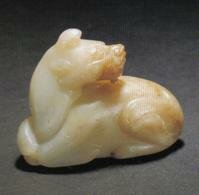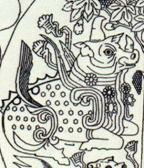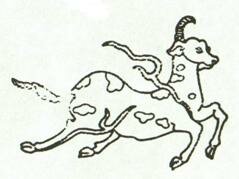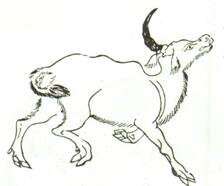Chapter 26. THE SPIRIT-RHINOCEROS-UNICORN XINIU
In spite of the fact that Tang Dynasty descriptions of the patterns on rhino horn are quite realistic, the belief in the magic powers of the tongtianxi (communicating with the sky rhinoceros horn) continued to flourish. In the Bencao shiyi (Omissions in Previous Works on Materia Medica) dating to the first half of the eighth century C.E. it says “as to the tongtianxi, the horn on its head elongates to a point after a thousand years. It is then adorned, from one end to the other, with white stars, and can exhale a vapour penetrating the sky; in this manner it can communicate with spirits, break the water and frighten fowl.” Li Sun, in his Haiyao bencao (An Account of Drugs of Southern Sea Countries), written in the second half of the eighth century, gives the following explanation for the origin of the designs in the tongtianxi horn:
The tongtianxi, during the time of pregnancy, beholds the forms of things passing across the sky, and these are reproduced in the horn of the embryo: hence the designation tongtianxi. When the horn, placed in a water-basin during a moonlit night, reflects the brilliancy of the moon, it is manifest that it is a genuine tongtianxi horn.
It is interesting to note that by the second half of the eighth century, the use of the term tongtianxi was no longer limited to the magical horn, but now included the whole pregnant, and, needless to say, mythic, rhinoceros-unicorn itself! As time went by, this idea of the magical connection between the tongtianxi and the phenomena of the sky became more widespread, and the Chinese came to believe that all rhinos, and not just the tongtianxi, could use their horns to communicate with the sky. As a result, a legend grew up in China which said that the peculiar designs within the rhino’s horn were formed when “the rhinoceros gazes at the moon.”
A comparative study of all passages concerned renders it clear that the rhinoceros is not associated with the spiritual, but with material heaven; that is, the sky. It is the stars of the sky which are supposed to be reflected in the veins of the horn. This means that the designs of the horn gave the impetus to the conception of connecting the rhinoceros with the phenomena of the sky. (Laufer, 1914, 137 n. 1)
This symbolic connection with heavenly phenomena may have contributed to what Shepard calls the “vague sanctity” surrounding the alicorn later in Europe, where it was venerated in numerous churches and monasteries ([1930] 1982, 109). It may also underlie the belief that the unicorn’s horn, “as in the case of gems, is so pure and splendid and starry that none can deny it a heavenly origin” (Megged, 1992, 13).
We know that the concept of a magical “spirit- rhinoceros-unicorn” must pre-date the mid-ninth century, because it is found in a poem by the famous Tang Dynasty poet Li Shangyin (813-58 C.E.). Li Shangyin led a very unhappy life, for although he placed second in the national examinations and found employment at the Chinese court, he was not appreciated. So he left the palace and wandered about the country becoming increasingly ill and depressed. Finally he went home and died around the age of 45. His poems, like his life, are very sad, but also very beautiful. This poem is simply entitled “To… “Thus we shall never know the name of the person to whom it was addressed.
Last night under the starlight,
last night in the wind!
To the west, your painted pavilion,
to the east, my hall of cassia …
Our bodies have not the wings
of the many-coloured phoenix,
But our hearts know the other truly
in every part.We sat ”guessing fingers”
the wine of spring warm;
Changing places we played at riddles;
candles glowed red,
Alas! I heard the morning drum –
must speed to the Court,
Spurred horse to Orchid Tower,
a piece of rootless tumbleweed.(Translated by Innes Herdan, [1973] 1984, 356)
In this poem Li Shangyin uses the characters lingxi (spirit rhinoceros) to express the idea that “our hearts know the other truly in every part.” In other words, although their bodies cannot be together, their hearts are connected by an unbroken line, like that between the magic vein in the tongtianxi’s horn, and the moon and stars in the sky. Later in China, this romantic idea from Li Shangyin’s poem would often be used as a euphemism for lovers. Although Li Shangyin uses the expression lingxi in the context of his poem, the word generally used to indicate the spirit- rhinoceros-unicorn is xiniu (rhinoceros-ox). Thus in the Chinese expression xiniu wang yue (spirit-rhinoceros-unicorn gazing at the moon) the term xiniu is used.
At present I am unaware of any excavated images of mythic xiniu surviving from the Tang Dynasty in China, but there is a silver bowl from Soghdia in Central Asia, dated to the second half of the seventh century, which shows a unicorn in the shape of an antelope turning its head back and reclining among vines (fig. 72).

Figure 72. Silver bowl with a mythic xiniu reclining among vines. 2nd half of the 7th century. State Hermitage Museum, Saint Petersburg
This type of xiniu was to become a popular motif in textile design during the Jin Dynasty (1115-1234 C.E.) and later, especially among minority peoples on the outskirts of the empire (fig. 73) (Krahl, 1997, 46).

Figure 73. A reclining xiniu among floral branches, gazing at the moon.
Jin Dynasty. Detail of a brocaded textile. Cleveland Museum of Art
On textiles, the xiniu is usually depicted in the form of a winged, antelope-unicorn with a goatee, which is shown reclining among plants and flowers, and turning its head backward to gaze up at the moon. The artistic convention of back-turning birds and animals is very ancient in China, dating back to the Bronze Age. In other media, such as the small jade carving in colour plate 37, the xiniu sports a single horn in the middle of its forehead, as well as a goatee, and wisps of qi vapour around its legs. Such mythic attributes clearly show its derivation from earlier Chinese images of the goat-unicorn zhi.

Plate 37. Small jade figure of a recumbent xiniu
Five Dynasties/Song Dynasty
Perhaps the most beautiful surviving example of a mythic xiniu is the bronze mirror stand in the Victoria and Albert Museum, London (colour plate 38) which is dated twelfth to fourteenth century C.E.

Plate 38. Xiniu mirror stand. Parcel-gilt bronze. Song/Yuan
Dynasties.
Victoria and Albert Museum. London
Here the mythic xiniu turns its head back gracefully to gaze up at the moon, which is represented by the mirror itself above a bank of clouds. This animal has been identified as a Central Asian antelope called a djeiran, with hooves, an ox-like tail, a single curving horn in the middle of its forehead, and a goatee (Watt and Wardwell 1997, 28). Nevertheless, this wonderful beast is clearly meant to represent a mythic spirit- rhinoceros-unicorn gazing at the moon—a xiniu wang yue. But this image then raises the question, what happened to images of rhinos during the Tang Dynasty and later?
By the Tang Dynasty, the Chinese had forgotten what a real rhinoceros looked like, and so they created their images of rhinos from the descriptions in early texts, such as the Erh ya and the Shuowen. It is important to stress once again the almost biblical quality attached to the written word in China. Once something was written down, it was automatically assumed to be true. Unfortunately, as was mentioned above, the early texts which describe the rhinoceros are brief and extremely cryptic. With so little to go on, it is hardly surprising that the artists of the Tang period had only a vague idea of how to depict a rhinoceros (figs. 74 and 75).

Figure 74. Drawing of a rhinoceros-unicorn on a Tang Dynasty bronze mirror back

Figure 75. Drawing of a rhinoceros-unicorn on a Tang Dynasty bronze mirror back
As Laufer remarks: “They set out to illustrate, not the rhinoceros, but the descriptions of it in the ancient dictionaries. They studied, not the animal, but the ready-made definitions of it encountered in book-knowledge. They read, and their reading guided the strokes of their brush” (Laufer, 1914, 100). As a result of this confusion, from the Tang Dynasty onward, images of rhinos becameever more fanciful (fig. 76).

Figure 76. Detail of a drawing of a Tang Dynasty textile showing a recumbent rhinoceros-unicorn. Shoso-in, Nara
In fact, except for one realistic rhinoceros sculpture in the Spirit Road of the Tang Emperor Gaosong’s tomb, what they produced were always rhinoceros-unicorns.
In the year 1063 C.E. a country in the South China Sea paid tribute to the Chinese court with animals which were described as “water buffaloes covered with flesh armour, with a horn on the nose, who eat fresh fruit” (Sun, 1982, 83-84). These were obviously rhinos, but there was much speculation on what they should be called: “mountain rhinos?,” or ”qilin?,” or “tianlu?,” or a combination of a water buffalo and a water dragon? This discussion indicates that by the eleventh century, even knowledgeable people had no idea what they were. By the Ming Dynasty, fourteenth to seventeenth century C.E., people knew even less about rhinos (fig. 77), and even herbal doctors who used rhinoceros horn for its medicinal properties did not know anything about the rhinoceros or its habitat (ibid.).

Figure 77. Drawing of a rhinoceros-unicorn from a Ming Dynasty bufu (surcoat)
Thus in the late Ming Dynasty, while the Sancai tudui offers many images of rhinos, they all show total confusion as to what a rhinoceros should look like (fig. 78).

Figure 78. Drawing of a rhinoceros-unicorn from the Sancai tudui
In another, similar example, the rhinoceros-unicorn is shown completely covered with fur gazing up at a crescent moon (fig.79).

Figure 79. Drawing of a rhinoceros-unicorn gazing at the moon
By the Ming Dynasty (1368-1644 C.E.), the idea of the mythic rhinoceros-unicorn using its horn to communicate with the sky had become so commonplace that no explanation was needed. Thus in chapter 92 of the famous novel Journey to the West, when Monkey is facing battle with three monster “spirit rhinos” called “Cold-avoider,” “Heat-avoider,” and “Dust-avoider” who have carried off his master to the Dark Essence Cave in Green Dragon Mountain, he says, “But these are not ordinary rhinos who gaze at the moon…. They have cultivated their conduct and found the Dao and are a thousand years old.” (Jenner, 2000, 3069).
In 1759 an edict was promulgated which governed the insignia to be worn by the various ranks of officials at the Qing Dynasty court. It was declared that military officials of the seventh and eighth degree were to wear an image of a rhinoceros on their buzi (rank badges). This was a singularly appropriate decision, considering the ancient connection between the rhinoceros and armour. In the splendid textile collections of the Royal Ontario Museum there are eighteen kesi (silk tapestry) rhinoceros buzi, two of which are illustrated here (colour plates 39 and 40).

Plate 39. Detail of a rhinoceros-unicorn (xi) on a Qing Dynasty buzi. ROM (950.100.41A)

Plate 40. Detail of a rhinoceros-unicorn (xiniu) on a Qing Dynasty buzi. ROM (950.100.34A)
Of course, by the eighteenth century, these mythic animals no longer resemble a rhinoceros in any way, shape or form. They are simply composites of many different kinds of mythic beasts.
The key to their identity as rhinoceros-unicorns is that they are always shown gazing up at a moon which appears in the clouds over their heads. It is the position of their heads which indicates whether they are meant to be mythic rhinoceros-unicorn xi, or mythic spirit-rhinoceros-unicorn xiniu, for the xi looks straight ahead, while the xiniu turns its head backward to gaze up at the moon. In Chinese art and culture, once a theme is introduced it seldom disappears and continues to reverberate down through the ages. Thus these images of rhinoceros-unicorns on Qing Dynasty buzi are simply the last vestiges of the ancient tradition of the magical tongtianxi, the rhinoceros communicating with the sky.